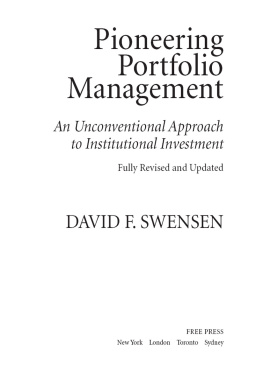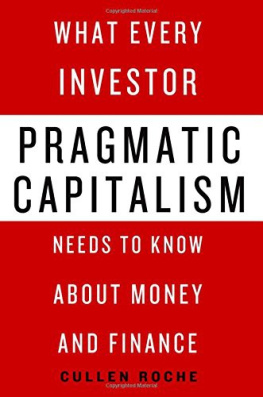
Table of Contents
List of Tables
- Chapter 3
- Chapter 4
- Chapter 5
- Chapter 10
List of Illustrations
- Chapter 2
- Chapter 3
- Chapter 4
- Chapter 5
- Chapter 6
- Chapter 7
- Chapter 8
- Chapter 9
- Chapter 10
- Chapter 11
Guide
Pages
Modern Portfolio Management
Moving Beyond Modern Portfolio Theory
TODD E. PETZEL

Copyright 2022 by Todd E. Petzel. All rights reserved.
Published by John Wiley & Sons, Inc., Hoboken, New Jersey.
Published simultaneously in Canada.
No part of this publication may be reproduced, stored in a retrieval system, or transmitted in any form or by any means, electronic, mechanical, photocopying, recording, scanning, or otherwise, except as permitted under Section 107 or 108 of the 1976 United States Copyright Act, without either the prior written permission of the Publisher, or authorization through payment of the appropriate per-copy fee to the Copyright Clearance Center, Inc., 222 Rosewood Drive, Danvers, MA 01923, (978) 750-8400, fax (978) 646-8600, or on the Web at www.copyright.com. Requests to the Publisher for permission should be addressed to the Permissions Department, John Wiley & Sons, Inc., 111 River Street, Hoboken, NJ 07030, (201) 748-6011, fax (201) 748-6008, or online at www.wiley.com/go/permissions.
Limit of Liability/Disclaimer of Warranty: While the publisher and author have used their best efforts in preparing this book, they make no representations or warranties with respect to the accuracy or completeness of the contents of this book and specifically disclaim any implied warranties of merchantability or fitness for a particular purpose. No warranty may be created or extended by sales representatives or written sales materials. The advice and strategies contained herein may not be suitable for your situation. You should consult with a professional where appropriate. Neither the publisher nor author shall be liable for any loss of profit or any other commercial damages, including but not limited to special, incidental, consequential, or other damages.
For general information on our other products and services or for technical support, please contact our Customer Care Department within the United States at (800) 762-2974, outside the United States at (317) 572-3993, or fax (317) 572-4002.
Wiley publishes in a variety of print and electronic formats and by print-on-demand. Some material included with standard print versions of this book may not be included in e-books or in print-on-demand. If this book refers to media such as a CD or DVD that is not included in the version you purchased, you may download this material at http://booksupport.wiley.com. For more information about Wiley products, visit www.wiley.com.
Library of Congress Cataloging-in-Publication Data is Available:
ISBN 9781119818502 (hardback)
ISBN 9781119818205 (ePDF)
ISBN 9781119818199 (ePub)
Cover Design: Wiley
Cover Image: MR.Cole_Photographer/Getty Image
To Kate, Sarah, Rebecca, and all the grandchildren who give support and joy in countless ways.
Preface
This book arose from a frustration over how the broad investment industry and specific funds and products are sold to the public. Having mostly been on the receiving end of these sales pitches for over 25 years, too often they are wrapped in a scientific mystique. People who are collectively responsible for trillions of dollars of assets are regularly told that they may not grasp the minutia, and they should trust those assets to fund managers who rigorously apply the science of finance to create superior risk-adjusted returns. While our understanding of finance is today far better than it was 50 years ago, it is far from complete and it never will be. Investing is a human endeavor, and because humans react to events and change behaviors, it will never be as orderly as the experiments in a high school physics lab. Managers pretending otherwise are guilty of hubris or deception. Unfortunately, many targets of these pitches are ill equipped to evaluate them carefully. The goal here is to provide the tools needed to better even the playing field.
Knowledge of a subject comes at different levels. At the most basic level one simply memorizes a formula, say for the Sharpe Ratio, and can parrot it back. The next level of understanding allows one to apply those learned principles to different situations to help analyze new problems. Level three allows one to teach others using everything on the first steps to bring new students along. The final level is when one does original research to move the knowledge frontier out. This book breaks little new research ground, but hopefully will help the interested reader to improve their understanding of portfolio construction to at least level two of the knowledge ladder. If it is successful it is because many people over many years have helped me better understand this fascinating and ever evolving process.
Acknowledgments are never complete as the people who contributed directly or indirectly are too many to count. This book is the product of more than 30 years of studying and participating in markets. Finding a single, good investment idea is not easy. Building effective portfolios is even harder. The challenge in producing this book was to distill all of that so that some of the many lessons learned could be passed on. Colleagues at Commonfund, Azimuth Partners, and Offit Capital expanded my understanding. Thirty years of market events etched lesson after lesson into my memory. A decade of teaching the course Endowment Institute with Bill Spitz and Andre Perold not only expanded my understanding of the topic but also honed the communication of that knowledge. These two colleagues and friends will see their fingerprints on many parts of this book.
Every major project has easy stretches and sticking points. As this manuscript was coming together, the sticking points were the many graphs and charts throughout. In the summer of 2019, Offit Capital was blessed with three interns: Jesse Rosenblatt, Jared Rosenbaum, and Brandon Rosenbaum, who came ready to do anything that was asked of them. This trio downloaded data, created figures, and updated charts for weeks on end. They took a book that was at the five-yard line, and like a great offensive line, made it easy to go in for the score. They did this with curiosity about the subject, enthusiasm, and good cheer. They deserve credit and great thanks.
Nobody can be effective in the investment world living on an island. The world changes too fast for that. Great partners and colleagues challenge you regularly and welcome your challenges. Ned, Dan, and Morris Offit invited me to join Offit Capital at its inception, and fourteen years later we, with our other partners and colleagues, still engage continuously in the process of trying to improve the investment experience of our clients. The Offits appropriately strive to build a great and lasting business, but they also understand that is achieved by putting client results first. This ethos runs deep and anyone who has met Morris Offit over his 80-plus years knows this is at his core. I am grateful and privileged to call these gentlemen my partners and friends. They created the world that allowed this book to be written.
One person that deserves particular mention is Peter Bernstein. He had nothing to do directly with the production of the book, but he had everything to do with its content. Peter was the ultimate scholar and skeptic when it came to investing. His descriptions of the market were never promotional. He sought the truth, which often placed him in the position of saying the emperor had no clothes. His communications were crisp and he rarely equivocated. He set the standard for a generation of investment professionals. There is nothing in this book where I did not ask myself how Peter could have made it better. There is no doubt this effort fell short, but aiming at his standards improved it.
Next page






